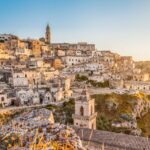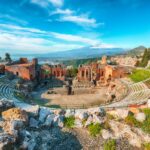Sicily is one of the most fascinating destinations to visit, it has something for everyone – whether your interest is in culture, history, cuisine or relaxing on the beach. Sicily is also a large island, and some planning before you tour Sicily you will enable you to get the most from your visit. Here are some of the key aspects to consider.
What to do in Sicily?
When visiting Sicily, most people focus on the aspects that are most distinctively Sicilian – the culture, history, beaches, and the cuisine.
Sicily’s culture has been defined by the numerous settlers and conquerors over the centuries, all of them leaving their mark in some way. This starts in ancient times with the Phoenicians and the Greeks, through to the centuries of Spanish rule. You can find evidence of these civilisations in the art, architecture, food, and cultural practices. By reading up on the local customs and traditions you will get a deeper insight into how Sicily’s history is still alive in what you see and taste, alternatively local guides are particularly good at pointing out these sometimes more subtle features. This ‘melting pot’ of influences is one of the key factors that draw people to Sicily, making it worth a visit for many reasons.
If the history isn’t your thing, join other holidaymakers and head to the beach. Sicily has numerous sandy beaches, and combined with the warm Mediterranean climate makes this an ideal destination for a seaside break.
A summer option is boating around the Aeolian Islands. These beautiful islands include Lipari and Stromboli, and you can find luxury hotels here.
One beautiful beach that we love is San Vito Lo Capo, with a small beach settlement alongside it and the Zingaro nature reserve nearby.
For the combination of an interesting town, great restaurants and a beach right there, go to Cefalu – and Cefalu can also be reached as a day trip by a short train ride from Palermo.
Where to go in Sicily?
The choice of destination within Sicily should be based around your own personal interests. The main entry points are the major cities, specifically in Palermo the port or the airport, and Catania airport.
Palermo is the place to go if you want a combination of art and architecture, culture, and cuisine. Here you find the unique Arab-Norman architecture, a fusion between the two cultures that can be found across the city. As you wander through Palermo you come across open air markets, street food vendors, the Teatro Massimo opera house, and even performances of the traditional puppet theatre.
If you prefer a small town feel, there is a trio of towns all close to each other in Eastern Sicily that are favourites of ours – Ragusa, Modica, and Noto. These towns together are recognised as a UNESCO World Heritage site for their baroque architecture, the elaborate decorations giving the buildings in the historic centers a fantastical feel. As well as this, see the annual Infiorata flower festival in Noto every May, or taste the special type of chocolate made in Modica.
To see the archaeological sites, the key places are Agrigento’s ‘Valley of the Temples’ dating to ancient Greek times, Segesta with its completely intact temple from 400 BC, the ancient Greek village of Cava d’Ispica, and the ancient ruins of Selinunte. Some of these should feature in any itinerary, as they are such a distinctive feature of the Sicilian landscape. Base the number of ancient sites on your own interest in history.
In terms of the Sicilian cuisine, the best places to visit depend on your interests. Some classic Sicilian dishes are found everywhere, meals such as ‘pasta alla norma’, or caponata. For other specialities within Sicily you can travel to particular areas. For example, at the western end of the island the local dish is ‘couscous alla trapanese’ – some people are surprised to find couscous in Sicily, it dates back to the time of Arab rule 1000 years ago. At the other end of Sicily, on the slopes of Mount Etna, is one of Sicily’s best wine growing areas. The volcanic soils and elevation of the vineyards, along with the local grape varieties, make these wines unique. Also around Mount Etna is the pistachio growing area, with the pistacchios being a common feature in cakes and baking.
Where to stay in Sicily?
Sicily offers everything from countryside lodges through to luxury hotels.
For an immersive experience in the more traditional side of Sicily, consider staying in one of the many rural estates. Often these are agricultural enterprises that have become boutique hotels. This is where you can retreat to for a more peaceful time after visiting the towns and cities. Many of these lodges have restaurants that feature locally grown products.
Staying in a small town is a good inclusion in your itinerary. The old town centre of Ragusa, called Ragusa Ibla, is compact and well suited to wandering through the pedestrianised central street in the evenings.
For luxury accommodation, Taormina is the key destination. Here you can find numerous 5 star hotels, good restaurants, the ancient Greek theatre, and stunning views over the coast and Mount Etna, an active volcano. Nearby is the beach of Isola Bella, reached by cable car.
For seaside charm, head to the island of Ortigia. This is the original part of Siracusa, and this island is now connected to the mainland by a short bridge. In Ortigia there are piazzas lined with cafes, narrow streets around the fish market to explore, and restaurants lining the waterfront overlooking the Ionian Sea. Here we recommend that you stay on or near the island of Ortigia, so you can move around on foot.
What is the best month to visit Sicily?
The best time to visit Sicily is what’s called the ‘shoulder season’. This includes the early summer months of May and June, and the late summer months of September and October.
August is a difficult month to travel around Sicily, as it is the hottest month. In addition, Italians take their holidays in August and Sicily is a very popular destination, in particular for the beach areas. August also has peak season prices.
Ideally avoid August, unless you want to join the Italian holidaymakers on the beach.
July is an option for a beach holiday, and less busy than August.
How many days is enough time in Sicily?
Given Sicily’s rich history, if you really wanted to you could spend many weeks there to cover all aspects of the island.
More realistically, several days at each end of Sicily are needed to be able to cover the key locations, with time to drive from place to place.
If you have a short period, for example 3 or 4 days, it is a good idea to focus only on either the Western or Eastern end of Sicily. This will avoid too much driving in a short time. Western Sicily includes Palermo, Agrigento and Segesta. Eastern Sicily includes Taormina, Siracusa and Ragusa.
Sicily Small Group Tours
Italy With Pleasure offers a 7 day Sicily Tour, covering a wide range of aspects including the traditional aspects of Sicily, a deep dive on the cuisine, and time to relax in the piazzas of small towns. If spending your time driving or on public transport doesn’t appeal, consider our Sicily Tour – you’ll maximise your time, without the stress, and see the best that Sicily has to offer. We also offer custom travel experiences tailored just for you. Please don’t hesitate to get in touch, we’d love to help you explore Sicily and create unforgettable memories!


